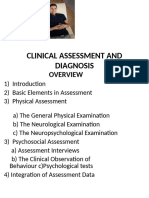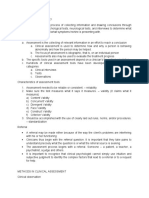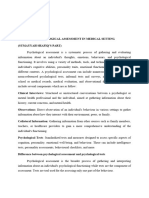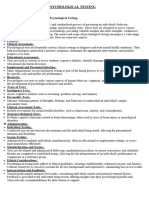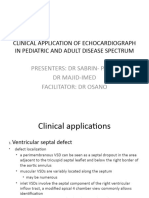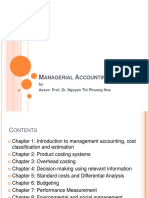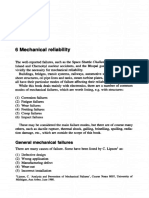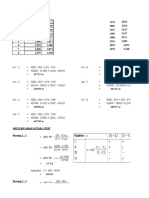Research Methods
Uploaded by
Salman MajidResearch Methods
Uploaded by
Salman MajidWhat is a randomized controlled trial (RCT) in clinical psychology?
;An experimental
design where participants are randomly assigned to treatment or control groups to
test intervention efficacy.;Extra: RCTs establish causality by balancing known and
unknown confounders. In clinical psychology, an RCT might compare cognitive
behavioral therapy (CBT) vs medication for depression. Randomization prevents
selection bias; controls (e.g., placebo or wait-list) isolate treatment effects.
List four research methods from Units 1 & 2 relevant to clinical
psychology.;Experiments; Correlational studies; Case studies; Self-report
surveys.;Extra: Experiments (e.g., lab-based tests of memory in Alzheimer’s
patients) yield causal insights. Correlations (e.g., stress levels vs symptom
severity) identify associations. Case studies (e.g., single PTSD patient
trajectories) explore rare conditions. Self-report (e.g., Beck Depression
Inventory) assesses patient symptoms quantitatively.
Name two advantages of RCTs in clinical psychology.;High internal validity through
randomization; ability to make causal inferences about interventions.;Extra: By
randomly assigning patients to CBT or medication, RCTs ensure groups are
comparable. Blinding further reduces expectancy effects. Consequently, observed
differences in outcomes can be attributed to the treatment, strengthening evidence-
based practice.
Name two limitations of RCTs in clinical psychology.;Ethical concerns when
withholding effective treatment; high cost and time demands.;Extra: It may be
unethical to give a placebo to suicidal patients. Recruitment and retention can be
challenging in long-term therapy trials. Additionally, strict inclusion/exclusion
criteria reduce generalisability to everyday clinical settings.
Define structural neuroimaging and give one example.;Structural neuroimaging
visualizes brain anatomy and detects abnormalities; example: Magnetic Resonance
Imaging (MRI).;Extra: MRI uses strong magnetic fields and radio waves to produce
detailed images of grey and white matter. CT (Computed Tomography) uses X-rays for
bone and lesion detection. In schizophrenia, structural MRI may reveal enlarged
ventricles.
Define functional neuroimaging and give one example.;Functional neuroimaging
measures brain activity during tasks; example: Functional Magnetic Resonance
Imaging (fMRI).;Extra: fMRI detects blood-oxygen-level changes (BOLD signal) while
patients perform cognitive tasks (e.g., emotion recognition). PET (Positron
Emission Tomography) uses radioactive tracers to show metabolic changes. fMRI
studies link prefrontal activation to CBT improvements in depression.
How are structural and functional neuroimaging used in clinical
psychology?;Structural imaging diagnoses brain lesions; functional imaging studies
neural correlates of mental disorders and treatment effects.;Extra: Structural MRI
can detect hippocampal atrophy in Alzheimer’s. Functional imaging (fMRI) shows
abnormal amygdala activation in PTSD. Clinicians use these to understand pathology
and monitor treatment-induced functional changes.
What information does a paper’s abstract typically contain?;A concise summary of
background, aims, methods, key results, and conclusions.;Extra: Abstracts allow
readers to quickly assess relevance. They include rationale (why study was done),
basic design (e.g., RCT with N = 100), main findings (e.g., significant reduction
in symptoms), and implications for clinical practice.
What is the purpose of the introduction in published psychological research?;To
review existing literature, establish theoretical background, and justify the
study’s hypotheses.;Extra: The introduction outlines what’s already known (e.g.,
prior CBT efficacy), identifies gaps (e.g., undernutrition in schizophrenia
inpatients), and formulates specific, testable aims (e.g., “We hypothesize social
support mediates self-esteem and depression”).
Why must a clinical psychology paper clearly state aims and hypotheses?;Aims guide
the research focus, and hypotheses predict relationships between variables for
empirical testing.;Extra: For an RCT, the aim may be to compare treatment A vs B;
hypotheses might state “CBT will reduce depressive symptoms more than medication.”
Clear hypotheses enable appropriate statistical tests and lend transparency to the
research.
What sections are found in the Method part of a clinical psychology
paper?;Participants; Materials (or Measures); Design; Procedure; Ethical
considerations.;Extra: “Participants” details sample size, demographics,
inclusion/exclusion criteria. “Materials/Measures” lists scales or imaging
protocols. “Design” specifies RCT, cross-sectional, or case study. “Procedure”
describes recruitment, randomization, blinding. “Ethics” covers informed consent
and HCPC guidelines.
What must the Results section include in clinical psychology research?;Objective
presentation of data: descriptive statistics, inferential test results, and
visualizations (Tables/Figures).;Extra: Reports means and standard deviations for
each group, test statistics (e.g., t(98) = 2.54, p = .013), effect sizes (Cohen’s d
= 0.50), and confidence intervals. Graphs (e.g., bar charts of symptom reduction)
clarify group differences.
What content goes into a Discussion section of a clinical psychology
paper?;Interpretation of findings, comparison with previous research, limitations,
and practical implications.;Extra: Discussion should explain whether hypotheses
were supported (e.g., “Underweight was higher in inpatients”), relate to prior
studies (e.g., Japanese vs Western obesity rates), acknowledge confounds (e.g.,
cross-sectional bias), and suggest clinical applications (e.g., monitor nutrition).
Explain the peer review process for psychological journals.;Submitted manuscripts
are evaluated by independent experts who recommend acceptance, revision, or
rejection.;Extra: After initial editorial screening, 2–3 anonymous reviewers assess
validity, methodology, and contribution. Authors revise based on feedback. Peer
review ensures scientific rigor but can be slow; publication bias may occur when
null results are unpublished.
What is the role of the Health and Care Professions Council (HCPC) for clinical
psychologists?;HCPC regulates and sets training/practice standards to protect
public safety and ensure professional competence.;Extra: Guidelines require
clinical psychologists to maintain CPD (Continuing Professional Development),
obtain informed consent, maintain confidentiality, practice evidence-based
interventions, and adhere to safeguarding and equality legislation.
Name three HCPC guidelines that clinical practitioners must follow.;Obtain informed
consent; maintain patient confidentiality; record keeping and data security.;Extra:
Practitioners must store records securely, share information only with consent or
legal requirement, and participate in regular supervision. They also must work
within their competence and make timely referrals if beyond scope.
List five statistical tests from Topic A (quantitative inference) relevant to
clinical psychology data.;Pearson’s r; Spearman’s rho; Chi-square test; Mann–
Whitney U; Wilcoxon signed-rank test.;Extra: Pearson’s r assesses linear
correlation (e.g., depression score vs social support). Spearman’s rho is used for
ordinal or non-normal data. Chi-square tests frequency differences (e.g.,
underweight vs normal). Mann–Whitney U compares two independent groups on non-
parametric data. Wilcoxon signed-rank tests paired data (e.g., pre/post-treatment).
List five data presentation methods from Topic B relevant to clinical
psychology.;Bar charts; Histograms; Scatterplots; Box plots; Frequency
tables.;Extra: Bar charts compare categorical outcomes (e.g., proportion
underweight vs normal). Histograms display BMI distributions. Scatterplots show
relationships (e.g., self-esteem vs depression). Box plots highlight median and
outliers in lab values. Frequency tables summarize categorical data counts.
When is Pearson’s correlation appropriate versus Spearman’s in clinical data?;Use
Pearson’s r when both variables are interval/ratio and normally distributed; use
Spearman’s rho when data are ordinal or non-normal.;Extra: For example, if
depression and self-esteem scores follow normal distribution, Pearson’s r
quantifies linear relationship. If score distributions are skewed (e.g., TG
levels), Spearman’s rho is safer.
How do you decide between a Mann–Whitney U test and an independent-samples t-
test?;Use Mann–Whitney U when comparing two independent groups with non-normal or
ordinal data; use t-test when data are interval/ratio and normally
distributed.;Extra: For comparing TC levels between underweight vs standard-weight
inpatients, if cholesterol values are skewed, use Mann–Whitney U. If values are
normally distributed, use t-test.
Why are box plots useful for summarizing lab results in a clinical study?;They show
median, interquartile range, and outliers, highlighting data spread and
skewness.;Extra: For FPG values, a box plot reveals central tendency and
variability. Outliers (e.g., extreme low FPG) stand out, prompting further clinical
investigation. This aids quick visual interpretation of group differences.




